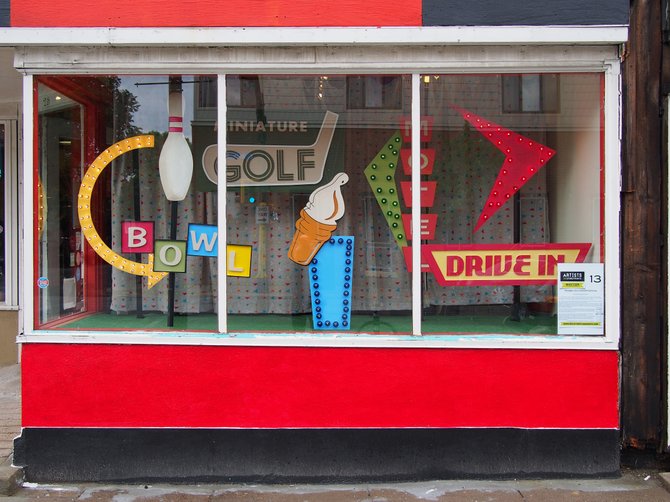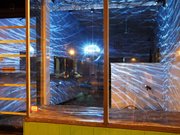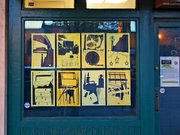Robin Schwartzmann displayed handmade neon signs at of Blacklist Vintage. in Whittier, Minn. Photo by Courtesy Steven Lang
When family or friends say Jackson is a bad place, I always want to take them on a trip to the city I've grown to know over the last six months.
Jackson has bad places, just like any other city or town, but it also has a lot of good places. I love my trips to Butterfly Yoga some Saturday mornings, most of which are followed by a turtle frappe from Cups. I love the trip I take to Pizza Shack once a week because I pass Belhaven and Midtown, and I love hearing about all the strides the city is taking to be a better place.
What I don't love is seeing empty storefronts along city streets. They are an eyesore on a beautiful street, an ouchie on a thriving community. A lot of the empty storefronts remain vacant for months, maybe even years. It's such a sad sight—the dusty boxes, papers and boards lying everywhere-—and it makes an otherwise great place look gritty.
While Jackson has yet to jump on this bandwagon, cities from Seattle, Wash., to Asheville, N.C., are taking initiative with empty storefronts. Instead of letting them gather dust for months and years, the cities bring in artists and artisans to display and often sell their wares, creating an excellent daytime-nighttime vibe for visitors and residents alike. In some programs, artists actually renovate the storefronts and make something unique out of the emptiness.
Why Art Up Storefronts?
• Fights the urbanization of historic retail areas
• Improves a falling economy
• Fosters an art community
• Gives awareness to empty spaces
• Beautifies an urban landscape
• Essentially creates a mini art gallery
• Gives artists a new way to market themselves
• Creates GOOD for the city
What Not to Do:
• Go about this by yourself. The arts community needs to band together to make it successful.
• Go into this without enough volunteers and resources.
• Just do it. Projects such as this take time and planning, and you must go through the proper channels, such as the city council, arts council and other groups to make it successful.
What Are the Problems?
• Pittsfield, Mass., experienced a huge drawback to artists renovating storefronts. Artists put in sweat equity to renovate these places, which caused the property value to go up, and bigger businesses then bought the artists out.
• It can be hard to convince absentee building owners to forego large rents to get creative vendors into spaces.
Inspiration:
On your next visit to cool cities like Austin, Texas, and Asheville, N.C., notice how many storefronts are now filled with artisan stalls and packed with people browsing day and evening. Snap pics and bring them back to help convince others it's a great idea.
Cities With Storefront Projects:
• Whittier, Minn., Artists in Storefronts, artistsinstorefronts.com.
• Seattle, Wash., Storefronts Seattle, storefrontsseattle.com.
• Springfield, Mass., Eugene Springfield Art Project, eugenestorefrontartproject.com.
• Pittsfield, Mass., Storefront Artist Project (project closed in 2011, but Pittsfield experienced a massive improvement in their art community over the last decade).
How It Happened
• Whittier, Minn.—Twin Cities artist Joan Vorderbruggen started the project in 2012. More than 120 artists showcased their art in area storefronts, including six permanent murals.
• Seattle, Wash.—Shunpike, a local arts group, launched the program in 2010 as a neighborhood-revival program designed to combat the urbanization of the city's historic retail core. Hundreds of artists have worked with the project. It recently expanded to neighboring areas, such as Mt. Vernon and Auburn, Wash.
• Springfield, Mass.—founded in 2010 after a disappointing turnout at a weekend art event. The founders wanted to foster the art community and beautify downtown.
• Pittsfield, Mass.—launched in 2002. The project's mission was to "forge a community of artists, entrepreneurs, businesses and residents." Though the project closed down in 2011, the city made great changes, seeing new businesses open, such as theater, galleries, restaurants, pop-up stores and coffee shops.
How Do We Improve Jackson Storefronts?
• Apply for a grant from the Greater Jackson Arts Council.
• Convince city leaders to get behind this kind of beautification.
• Find volunteers and interested realtors/store owners.
• Put a call out for donations to get it started.
• Put out a call for local artists.
• Create beautiful storefronts.
• Have pop-up artist galleries in empty spaces.
See also:
Vision 2022: A Regional Vision
Big Ideas: Getting Jacksonians into City Parks
Bright Idea: Conserve Energy, Create Jobs
Best Practice: Mid-South Minority Business Council Continuum





